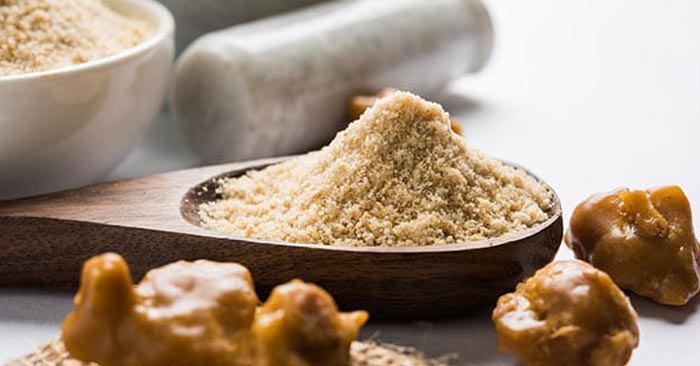What Is Asafoetida? Benefits, Uses and Side Effects

Asafoetida (Ferula asafoetida) is the dried sap obtained from the roots of Ferula plants. Technically a gum-resin, asafoetida is a hard substance that’s extracted from large, carrot-shaped roots of the Ferula plants. Once extracted, it’s commonly dried, ground into a coarse, yellow powder, and used for either culinary or medicinal purposes.
As a spice, asafoetida is known for its strong, pungent odour, which is due to its high concentration of sulfur compounds. In fact, due to its unpleasant smell, this seasoning is sometimes referred to as stinking gum. In addition to flavouring food, asafoetida has also been used for centuries around the world for its perceived health benefits. While it’s native to Afghanistan and Iraq, asafoetida is commonly used in Indian cuisine where it’s dried, ground into a spice, and referred to as hing.

However, when cooked, its flavour and smell become much more palatable and are often described as being similar to leeks, garlic, and even meat. In addition to adding a distinct flavour to dishes, asafoetida has been used in traditional medicine for centuries.
For example, in Ayurvedic medicine, hing is used to aid digestion and gas, as well as treat bronchitis and kidney stones. While during the Middle Ages, the dried gum was sometimes worn around the neck to help ward off infection and disease. Yet despite being used for thousands of years, many of the traditional uses of asafoetida have not been proven by modern science.

Potential benefits of asafoetida:
Good source of antioxidants
Asafoetida has been found to be a good source of antioxidants. These plant compounds help protect your cells against potential damage caused by unstable molecules called free radicals. As a result, antioxidants may also help protect against chronic inflammation, heart disease, cancer, and type 2 diabetes.
Specifically, asafoetida has been shown to contain high amounts of phenolic compounds, such as tannins and flavonoids, which are known for their potent antioxidant effects. While test-tube and animal studies have found asafoetida to exhibit anti-inflammatory and antioxidant activity, more research needs to be done on its potential antioxidant effects in humans.
Asafoetida is used in such small amounts when cooking, it’s unclear if culinary use of the spice would still provide these potential benefits to health.
Good for digestion
One of the most common uses of asafoetida is helping with indigestion. In one 30-day study in 43 adults with moderate to severe indigestion, those taking 250 mg capsules containing asafoetida twice a day reported significant improvements in bloating, digestion, and overall quality of life compared with the placebo group. This study was funded by the company that produced the supplement, so it may have impacted results.
Asafoetida has also been shown to help boost digestion by increasing the activity of digestive enzymes. Specifically, it may increase the release of bile from the liver, which is needed for the digestion of fat. While the spice is also frequently used to prevent or reduce gas after eating, there’s currently a lack of research to support this effect.
May help reduce symptoms of IBS
Irritable bowel syndrome (IBS) is a chronic gastrointestinal (GI) condition that’s characterized by abdominal pain or discomfort, bloating, gas, and constipation, diarrhoea, or bot. Due to its potential effects on digestion, asafoetida is thought to help reduce symptoms associated with IBS. Two small studies in adults with IBS found a significant improvement in reported IBS symptoms after 2 weeks of taking asafoetida supplements. Yet another study found no effect of the supplement on IBS symptoms.
Overall, the research on whether asafoetida may be effective for managing IBS symptoms is quite limited. However, one less direct way that asafoetida may be beneficial for individuals with IBS is as a substitute for onion and garlic in cooking.
Onion and garlic contain high amounts of fructans — indigestible, fermentable carbs that can cause GI distress in some individuals with IBS. As asafoetida provides a flavour similar to onions and garlic, it could be a good option for those who need to avoid or limit their consumption of these high fructan foods.
Other possible benefits
While studies on asafoetida are quite limited, early research suggests that it may have additional benefits, including:
Antibacterial, antifungal, and antimicrobial effects: Test-tube studies have found asafoetida may help protect against potential pathogens, such as various strains of Streptococcus bacteria.
Help lower blood pressure: Asafoetida may help lower blood pressure by relaxing blood vessels. However, research is very limited and has only been studied in animals.
Anticancer effects: Animal and test-tube studies have shown a potential for asafoetida to help stop the growth and spread of certain cancer cells, including breast and liver cancer.
Protect brain health: Several animal studies have found asafoetida may help protect against memory loss and nerve damage in the brain.
Help ease asthma symptoms: Mice studies have shown asafoetida to have a relaxing effect on airway smooth muscles, which is important in the treatment of asthma. While promising, this effect hasn’t been proven in humans.
Help lower blood sugar levels: One study in rats found 50 mg/kg of asafoetida extract to reduce fasting blood sugar levels. However, this effect hasn’t been studied in humans.
Overall, while animal and test-tube studies suggest many potential benefits of this pungent spice, there’s currently a lack of evidence in humans to support these claims.
It’s also worth noting that these studies use a concentrated form of asafoetida rather than the amounts typically used when cooking. As a result, culinary use of the spice may have minimal effects. Asafoetida is rich in antioxidants and may provide multiple health benefits, particularly for digestive health. However, as research is currently limited, studies in humans are needed to confirm these effects.
Potential side effects of asafoetida
While research on the safety of asafoetida in humans is limited, amounts of asafoetida that are typically used in cooking are thought to be generally safe for most individuals.
One study in humans found 250 mg twice per day for 30 days was well tolerated by the participants.
However, animal studies suggest large doses of asafoetida may cause swelling of the mouth, gas, diarrhea, anxiety, and headaches. Furthermore, a study in mice suggests possible toxicity at doses greater than 455 mg per pound (1,000 mg per kg) of body weight.
Additionally, due to a lack of research, asafoetida isn’t recommended for women who are pregnant or breastfeeding or young children.
Because it may lower blood pressure or thin the blood, people on blood pressure medications or blood-thinning drugs should avoid asafoetida supplements.
When used as a spice, asafoetida is often mixed with either wheat or rice flour. As a result, asafoetida (or hing) products may not be gluten-free. This can be a particular concern when dining out at a restaurant that uses hing powder in their dishes.






